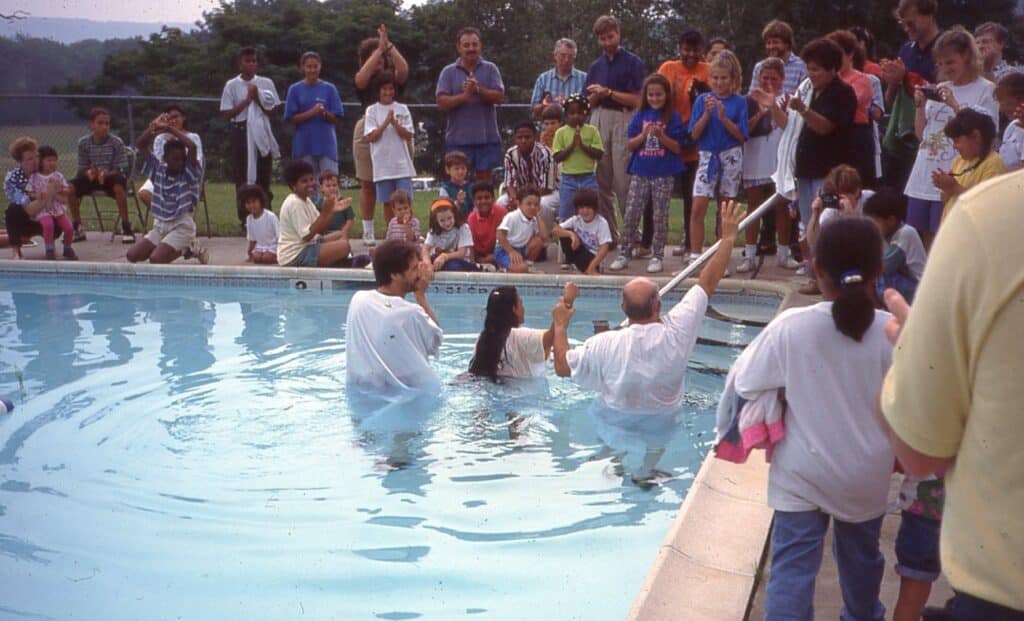A Whole Lot of Faith
John Smucker, originally from Bird-in-Hand, Pennsylvania, had been pastoring a Mennonite church plant in New York City for about 10 years when he first heard talk about the possibility of the New York City Mennonite churches buying and operating their own camp. His other pastor friends, Paul Burkholder, Glenn Zeager and John Freed, were looking at a piece of land about 80 miles away from the city. John said he decided to go look at the land and see if he wanted to jump on board. “The first time, it was me and Dale Stoltzfus and Glenn Zeager and a few other leaders,” he said “and we went there with a whole lot of faith.”
Once there, John was sure this was the place that would be perfect for the camp they envisioned. Everybody loved the quiet woods and the open space for activities. “When we got up there, we really liked the setting,” he said. In fact, he said, they wanted to buy the property, “but we didn’t have any money.” John described the congregations as “half a dozen young churches in New York—just church plants—but we had good connections with Lancaster Conference and (what is now) Atlantic Coast Conference.”
This connection to the broader Mennonite Church was important because both conferences had churches scattered throughout Lancaster County, which was the home community of most of the New York City Mennonite pastors. They sent people into Lancaster County to visit churches and ask for donations from private individuals and congregational offerings.
As they waited for the donations to come in, the pastors and leaders prayed. There was a clear vision for a camp where New York City youth and churches could get away from the city and worship God. John describes “a great unity” and recognition of “a need for a place to call our own.” Until that time, churches in New York City were using other Mennonite and Brethren in Christ camps that were farther away—and the churches didn’t have a strong connection to, or influence on, those camps.
Eventually they had enough money to officially buy the land. When Camp Deerpark first opened, people naturally compared it to other camps. “What we had to offer was always kind of meager,” he said. “It wasn’t high-falutin in any way. Those motels in the back, they weren’t great, but they were the best we had.” And, he added, “People loved it! They wanted to be together, and they liked the feeling of ownership.”
John’s congregation, Mennonite House of Friendship (Bronx, New York), went to Camp Deerpark for congregational retreats, which often included baptisms. John describes the setting as being conducive to “conveying spiritual and Biblical truth,” and says that the retreats were “an opportunity to get to know your people more deeply.” Camp Deerpark, he said, “was always a place where you could go and meet God, hear God speak to you.”
Reflecting on where camp came from, and where it is going, John said, “We took this old camp worth $125,000, and we got it for $85,000. We didn’t have any money, but we raised the money for it.” At the time, with such limited funds, he wasn’t sure how long the camp would last. But five decades later, Camp Deerpark not only continues to be a special place, but it also has expanded. “I think Camp Deerpark combined the city and the country. That was not easy—and they are still doing it. People love Camp Deerpark. It has a lot of friends!”
—Written by Dillon Hershey, Goshen College intern.
John Smucker served as founding pastor of Friendship Community Church(Mennonite House of Friendship) in the Bronx from 1957–1979; founding pastor of Immanuel Community Church from 1983–1995 in Queens; pastor of First Presbyterian Church of Flushing from 1995–2008 in Flushing; and overseer-bishop of the Atlantic Coast Conference of the Mennonite Church in New York City.
Related Entries
Share:
“How Do I Donate?”
Recently, a thirteen-year-old guest at Camp asked Operations Director Kevin Smith, “how do I donate?” Kevin was honestly a little surprised, but was happy to see this young member – who was on retreat with one of our owning churches — taking some initiative. Kevin directed him to the website Donate page, and the young…
The Discipleship Down-Low
Defining Discipleship 18 And Jesus came and said to them, “All authority in heaven and on earth has been given to me. 19 Go therefore and make disciples of all nations, baptizing them in the name of the Father and of the Son and of the Holy Spirit, 20 teaching them to observe all that I have commanded…
The Virtuous Wife
This past weekend, Camp hosted three women’s retreats at Camp. Though the retreat groups were very diverse in background – one was from an urban church plant in Philadelphia, one was from a Garifuna Mennonite church in Brooklyn (an Afro-Caribbean Culture), and one was from a multi-ethnic faith community reaching out in North Jersey. Though…
A Life of Service
I believe the most important thing to God is not our personality, knowledge, or talents, but our availability. How willing and ready are we to respond when He calls, and how ready are we to do what He says? What use to the Lord are people who could do what he wants with excellence and…
Building Belonging
At our February NYC LMC District meeting, we’re discussing the Belonging phase of The Journey Map. In this first phase on the map, individuals and groups on a spiritual journey begin the process of connecting to each other and evaluating the place they may have in each other’s lives. Have you ever been an outsider…
What Are You Tapped Into?
Yesterday we began tapping maple trees, officially opening maple syrup making season at Camp Deerpark! Last year, the transition kept us from producing syrup, so it feels great to be back to it. Starting off, however, has been a bit of a challenge since things are pretty arctic around here. The entire ground is covered…
What Does it Mean to be Spirit-Led with Pastor Mark Perri
One small contribution I can make is to share story with you. This could be valuable in several ways: First, I’m coming to the Mennonites from the outside — from non-denominational GenX “simple/ organic/ emergent church“. Sometimes people coming from outside-in have a helpful perspective for those trying to move from inside-out. Second, as an…
2025 NYC LMC District Call Schedule
Mark these dates in your calendar if you’re part of the NYC LMC District and want to attend the English-language fellowship and resourcing calls led by Bishop Hyacinth Stevens: January 27th – 6:30 PM February 24th – 6:30 PM March 31st – 6:30 PM April 28th – 6:30 PM May 19th – 6:30 PM June 30th…
Winter: Life Under the Surface
On the surface, winter with its cracking and cold seems like the enemy of life. Everything sleeps as though dead, and Camp — quiet and empty — sits waiting. But under the surface, winter is revealed to be a friend to life, not an enemy. In the deep frost, God opens the soil for Spring’s…
Peace Making Presents
This is Session 4 of the Prince of Peace: Jesus and Peacebuilding from the Election to the Holidays webinar series. Advent celebrates the central fact that God began building peace with us by giving a Gift. Following this example, gifts are a powerful tool for peacebuilding in our lives, relationships, and organizations. We’ll explore how…



